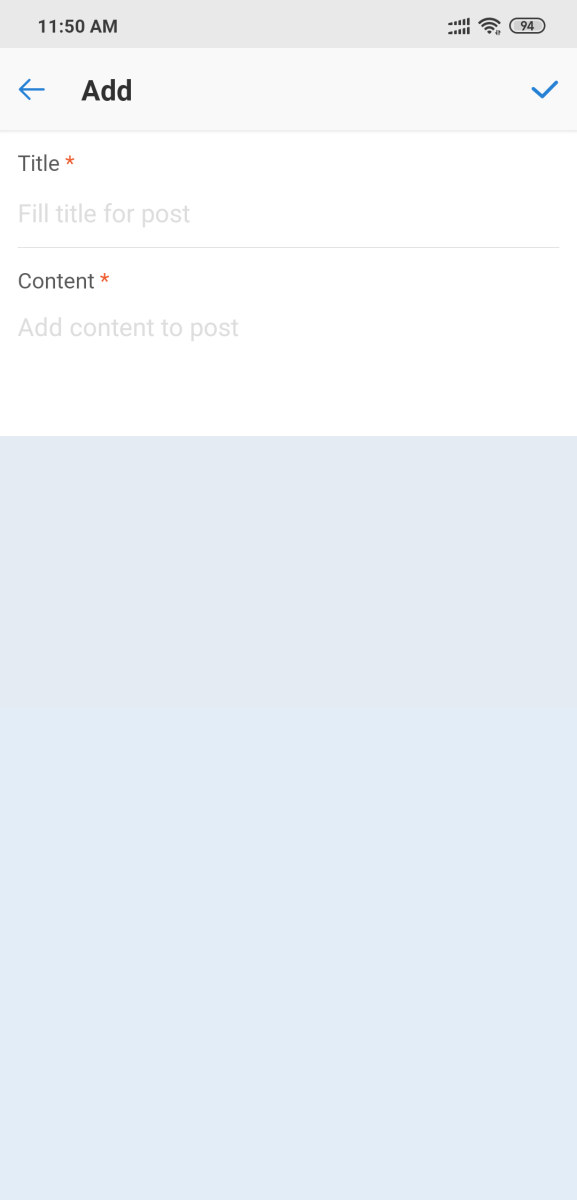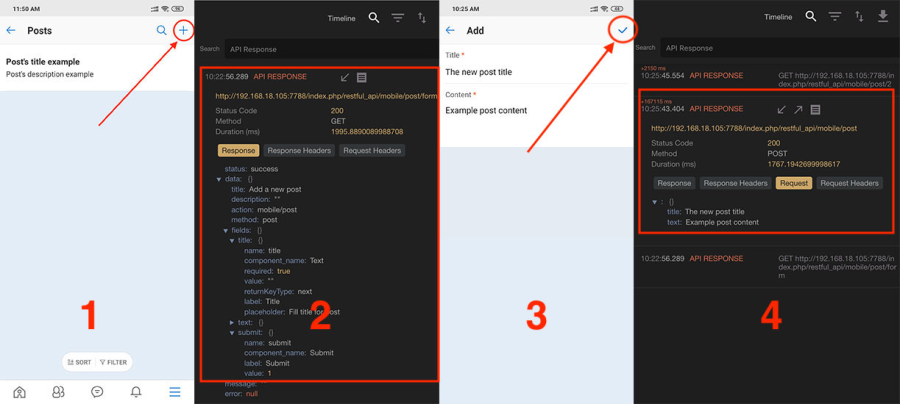Tutorial 3: Add new Create Button and connect to create a new post Form
Tutorial 3: Add new Create Button and connect to create a new post Form
To able user create a new post, we need to add a button and navigate the user to create form.
Step 1: Add a button to the app's home screen
Extends the PostApi::getAppSetting method in the previous tutorial as follows
PostApi.php
/**
- @param $param
- @return MobileApp
*/
public function getAppSetting($param)
{
$app = new MobileApp('post', [
'title' => 'Posts',
'home_view' => 'menu',
'main_resource' => new PostResource([])
]);
// Add create post button on App's home screen
$app->addSetting('home.header_buttons', [
'post' => [
[
'icon' => 'plus',
'action' => Screen::ACTION_ADD,
'params' => [
'resource_name' => 'post',
'module_name' => 'post'
]
]
]
]);
return $app;
}
Step 2: Create the creation form
Native Mobile App allows creating forms via API. The form API return form structure in JSON and base on the structure Mobile App automatic create a screen with form, fields and drive submit action.
The GeneralForm class as a base class help for build forms and handling submission, validation... Create a post form as follows code
PostForm.php
<?php
namespace Apps\Posts\Api\Form;
use Apps\Core_MobileApi\Api\Form\GeneralForm;
use Apps\Core_MobileApi\Api\Form\Type\SubmitType;
use Apps\Core_MobileApi\Api\Form\Type\TextareaType;
use Apps\Core_MobileApi\Api\Form\Type\TextType;
use Apps\Core_MobileApi\Api\Form\Validator\StringLengthValidator;
class PostForm extends GeneralForm
{
/** - Override build form to generate form
- @return mixed
- @internal param array $data
*/
public function buildForm()
{
$this
->addField('title', TextType::class, [
'label' => 'title',
'placeholder' => 'fill_title_for_post',
'required' => true
], [new StringLengthValidator(5, 100)])
->addField('text', TextareaType::class, [
'label' => 'content',
'placeholder' => 'add_content_to_post',
'required' => true
], [new StringLengthValidator(5)])
->addField('submit', SubmitType::class, [
'label' => 'submit',
'value' => 1
]);
}
}
Above code, we have added 3 fields Title, Text and Submit button to a form. The field type decides which native component will be used to generate the form element on the Mobile Device.
The Phpfox Mobile App has a lot of pre-defined form elements, All supported form elements will be defined in this post.
Then, need to implement Get Form API of the current resource. Back to PostApi class and implement PostApi::form() method
PostApi.php
<?php
namespace Apps\Posts\Api\Service;
use Apps\Posts\Api\Form\PostForm;
use Apps\Posts\Api\Resource\PostResource;
class PostApi extends AbstractResourceApi implements MobileAppSettingInterface
{
/.../
public function form($params = [])
{
$form = $this->createForm(PostForm::class, [
'title' => "Add a new post",
'action' => UrlUtility::makeApiUrl('post'),
'method' => 'post'
]);
return $this->success($form->getFormStructure());
}
}
Now check the Get Form API. API Url "url/restful_api/mobile/post/form?access_token=token" and the API response result as below
API response with form's structure
{
"status": "success",
"data": {
"title": "Add a new post",
"description": "",
"action": "mobile/post",
"method": "post",
"fields": {
"title": {
"name": "title",
"component_name": "Text",
"required": true,
"value": "",
"returnKeyType": "next",
"label": "Title",
"placeholder": "Fill title for post"
},
"text": {
"name": "text",
"component_name": "TextArea",
"required": true,
"value": "",
"returnKeyType": "default",
"label": "Content",
"placeholder": "Add content to post"
},
"submit": {
"name": "submit",
"component_name": "Submit",
"label": "Submit",
"value": 1
}
}
},
"message": "",
"error": null
}
Step 3: Handle form submission
Above form's structure has defined the action and the method, this information route the form submission to the corresponding API. Then the handling code implements at PostApi::create() methods.
PostApi.php
<?php
/* PostApi.php code */
/** - Create new document
* - @param $params
- @return mixed
- @throws \Exception
*/
function create($params)
{
// Create PostForm instance
$form = $this->createForm(PostForm::class);
// Get submitted values and validate
if (($values = $form->getValues()) && $form->isValid()) {
// TODO: Your business code to save the values as a new post to database
$newPostId = 2;
// Return success and needed information to communicate with Native Mobile App
return $this->success([
'id' => $newPostId,
'resource_name' => 'post',
'module_name' => 'post'
]);
}
return $this->validationParamsError($form->getInvalidFields());
}
Following image show detail of workflow between actions on Mobile App and Server API were recorded via the Reatotron App.
Step 4: Handling update the post
Similar to creation workflow, The code of the API form structure can be reuse and the API call from the App will add ID parameter /post/form/post_id. The edit post link will be defined in the action menu of each post.
The handling update submission now implement in PostApi::update() method


